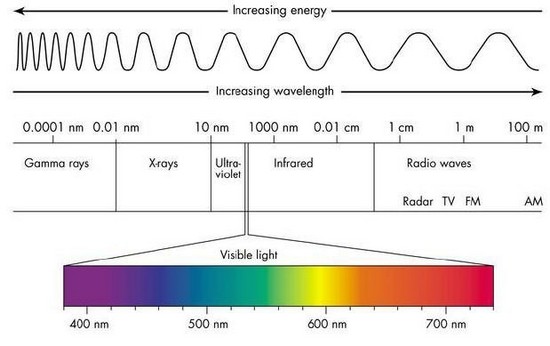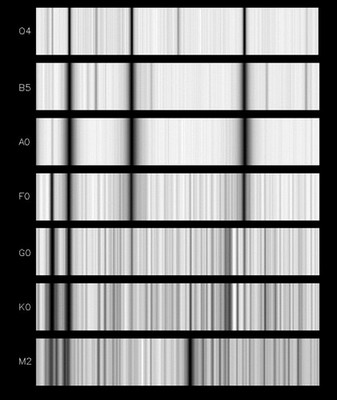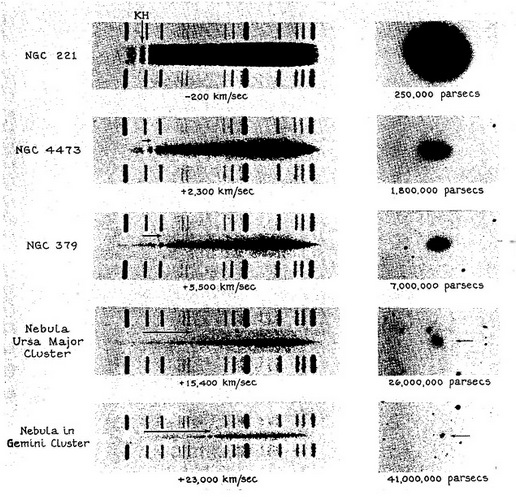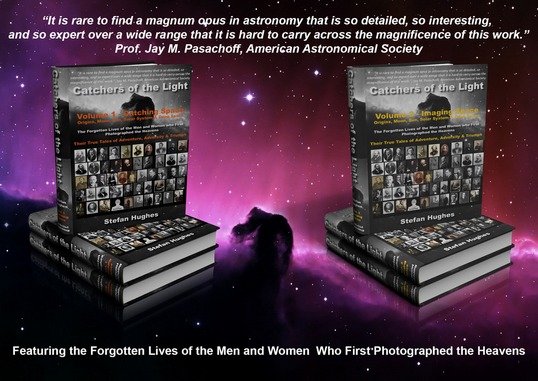Photographic Spectra
The single most important use of Photography in astronomical research is in the field of Astronomical Spectroscopy. It proved to be an invaluable tool not only for the study of the composition and origins of Stars, Nebulae and Galaxies, but more importantly, it was used to measure Galactic Redshifts; and was therefore able to put a ‘yardstick’ on the size of our universe.

The Electromagnetic Spectrum
Vega
For over thirty years after John William Draper took his photograph of the Moon in 1840, the use of spectroscopy for astronomical research was done by visual observation and hand made drawings. Only in 1872 did his son, Henry Draper photograph for the first time the spectrum of a star, when he imaged Vega (Alpha Lyrae), using a 28-inch (72 cm) reflector and a quartz prism.
Spectra
However by this date Astronomical Spectroscopy had been put on a firm scientific footing by others, and in particular most notably: Lewis Morris Rutherfurd (1816-1892), William Huggins (1824-1915) and the Jesuit Priest Pietro Angelo Secchi (1818-1878).
In 1862 Rutherfurd had published a paper in the American Journal of Science on the spectra of the moon, planets and stars. This was the first paper published on the subject since those of Bunsen and Kirchhoff, and continued the work begun by Joseph Von Fraunhofer in 1814. It included the first attempt at classifying stars based on their spectra. Two years earlier, the Italian astronomer Giovanni Battista Donati, had begun a series of observations on the spectra of the ‘fixed stars’, the results of which he published in 1862. The chief feature of Donati’s classification was his separation of the various stars according to their colours.
Secchi had begun work on classifying the spectra of stars based on their spectra in 1863. Three years later he had created three types now known as Secchi classes. he added a fourth the so called carbon stars in 1868. A fifth was added in 1877. Even as late as the 1890s a number of astronomers were still using his system.

Fraunhofer Spectrum of the Sun
The 'Father of Astronomical Spectroscopy'
Huggins who has been called the father of astronomical spectroscopy was not so much interested in the classification of stellar spectra but in determining whether a common set of chemical elements existed in the universe as they did on our Earth.
He began studying the spectra of the ‘fixed stars’ with this aim in mind with the chemist and neighbour William Allen Miller. In 1863 they published a paper entitled ‘On the lines in the Spectra of Some Fixed Stars’. This was followed by other papers on the spectra of various stars, which showed that each contained a selection of lines also visible in the Solar Spectrum. That same year they tried to photograph the spectra of the star Sirius, but failed.
A year later in 1864, Huggins made one of his greatest discoveries when he recorded the spectra of ‘Cat’s Eye Nebula’ (NGC 6543), a bright Planetary Nebula in Draco. Instead of a series of spectral lines he found only a single bright Emission line. He concluded that this was due to gas, thus proving that certain ‘nebulae’ were in fact gaseous and not made up of individual stars.
Draper Catalogue of Stellar Spectra
In 1882 Edward Charles Pickering, the Director of the Harvard College Observatory began a programme of astronomical spectroscopy using objective prisms. This type of setup enabled up to 200 stellar spectra to be captured on a single photographic plate. This work was continued under the auspices of the Henry Draper Memorial, a fund set up by the widow of Henry Draper to honour his work in the field of astronomical spectroscopy.
In 1890 the Draper Catalogue of Stellar Spectra is published by Edward Charles Pickering, which contains the photographic spectra of 10,351 stars, nearly all of them north of 25° south declination. In this work the spectrum of each star was classified according to a scheme developed by Williamina Fleming (1857-1911). In her system known as the ‘Draper Classification’, the letters A to Q (omitting J) were used to classify stellar spectra.
Fleming’s system was later modified by Annie Jump Cannon into the familiar Harvard Classification based on the spectral types: O, B, A, F, G, K and M, arranged according to the surface temperatures of the stars, such that those of Class O (blue-white stars) were the hottest and those of Class M (red stars) the coolest.

Harvard Classification of Stellar Spectra, 1890
The MKK Classification of Stellar Spectra
In 1943 a new system was introduced by the astronomers William Wilson Morgan (1906-1994) and Philip Childs Keenan (1908-2000), together with their photographic assistant, Edith M. Kellman (1911-2007).
The MKK system named after its authors, differed from that of Harvard’s in that it was a two dimensional system based on both temperature and luminosity, whilst the Harvard classification was based on surface temperature only. The MKK system was revised in 1953 and renamed the MK or Morgan-Keenan classification. This system is currently the accepted method for the classification of stellar spectra.
'Yardstick'
Perhaps the greatest and most widely known use of astronomical photographic spectroscopy is as a 'Yardstick' for measuring the size of the Universe. At Mount Wilson in the late 1920s, Edwin Powell Hubble (1889-1953) and Milton Lasell Humason (1891-1972) began a programme of work aimed at extending Hubble’s own measurements of galaxy distances based on Shapley’s Cepheid period-luminosity data and using Slipher’s galactic redshift measurements.
During the course of this work they discovered that there existed a roughly linear relationship now known as Hubble’s Law, between the distance of a galaxy and the value of its recessional redshift velocity. Although they were not the first to suspect that a relationship existed between ‘redshifts’ in a the spectra of external galaxies and distance, it was Hubble and Humason in 1929, who quantified it in mathematical form, drew a graph of it and proved conclusively of its existence by observational means. Extra-Galactic 'Redshifts', Milton Lasell Humason, 1936
Extra-Galactic 'Redshifts', Milton Lasell Humason, 1936
Quote
“No reference has been made to the use of the prismatic camera or grating spectrograph, as these are beyond the limits of an elementary treatise.”
Henry Hayden Waters (1880-1939), from Astronomical Photography for Amateurs, 1921.
To read more on this subject read the eBook chapter on Photographic Astronomical Spectroscopy or buy the eBook 'Catchers of the Light'.

Buy the eBook or Printed Book at the 'Catchers of the Light' shop.